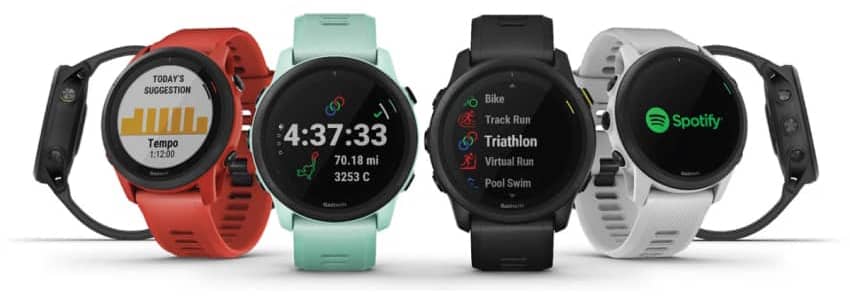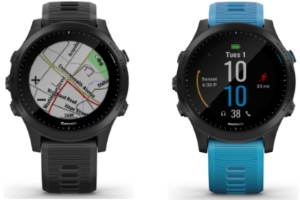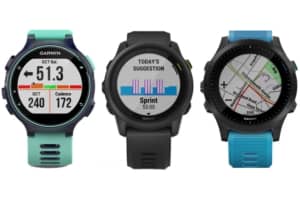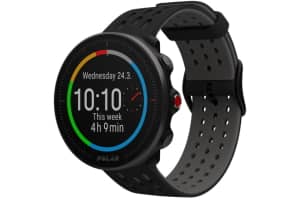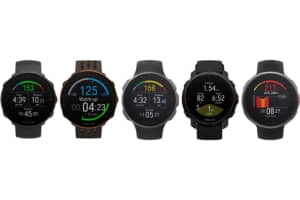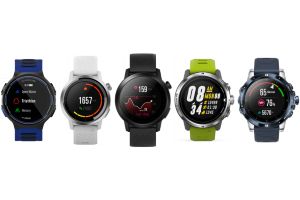Features of the Garmin Forerunner 745
47 g
Dimensions
43.8 x 43.8 x 13.3 mm
Display
Color 240 x 240 px, 1.2" (30.4 mm), MIP, Corning Gorilla Glass
Autonomy
16 hrs / 6 hrs / 21 hrs / 7 d
GPS / GPS+Music / Ultra / Watch with tracking
GPS
GPS, GLONASS, Galileo
True multi-sport
Yes
Recommended Activities
Running, Triathlon, Trail, Cycling, Swimming, Outdoor (skiing, hiking), 35+ profiles available
Connectivity
iPhone, Android. Bluetooth and Wi-Fi wireless data transfer
Cardio frequency meter
Yes, wrist optical, belt or armband
Topographical maps
-
Music player
Yes, MP3
Garmin Pay
Phone / 4G
-
Barometric altimeter
Yes
Compass
Yes
Thermometer
Yes
Weather
Yes
Waterproof
5 ATM (50 m), usable for swimming
Other
Pulse oximeter, ClimbPro hill analyser displaying flat/descent/climb, PacePro, corrected VO2max (altitude, heat, terrain), running dynamics, physiological measurements (VO2max, stress, training load, etc.), comprehensive features for triathlon and its activities, mountain biking, trail, skiing, athletic track profile
Other models
Garmin Fenix 6
Garmin Forerunner 945
Garmin Enduro
Garmin Forerunner 745 at a glance: should you buy it?
The Garmin Forerunner 745 is a top-of-the-range multi-sport watch for running and triathlon. It replaces, in a much more complete way, the Forerunner 735XT, dating from 2016, a reference at Garmin for triathletes.
So here is the new model, much more complete but also much more expensive! It is also only slightly less expensive than the much sought-after Forerunner 945, which until now has been the only triathlon watch available from Garmin, along with the Fenix 6 and, more recently, the brand new Garmin Enduro watch with record-breaking battery life. Sportsmen and women who were expecting a triathlon watch at an affordable price will therefore be disappointed. However, they can look forward to the excellent Polar Vantage M2, which will be released in 2021.

The advantage of the Forerunner 745 over the Forerunner 945 is that it is more compact and lighter, yet less expensive. It has almost all the features of the Forerunner 945, except for mapping and golf features. It also lacks interchangeable wristbands without tools. The accuracy of the measurements, especially the GPS, is very good. On the other hand, and this is the black spot of this watch, the autonomy is rather mediocre: 16 hours in GPS training mode. This is far from the 36 hours of the Forerunner 945 or even the 24 hours of the Forerunner 245!
That said, this new, slightly cheaper model is attractive for its richness of functions. The watch is packed with sensors (GPS, barometer, barometric altimeter, wrist cardio, oximeter, compass, accelerometer, gyroscope, thermometer) and is compatible with external sensors via Bluetooth and ANT+. It offers numerous functions for training, performance monitoring and rich physiological measurements. It offers comprehensive health tracking, safety features and many smart functions, including an MP3 player and a contactless payment solution. It is also designed for outdoor sports (hiking, skiing, snowboarding) and trail riding and offers advanced GPS navigation.
Among the new features introduced by this model is Training Suggestions, a function similar to FitSpark at Polar. The watch takes into account the current physical condition and past training to suggest targeted and personalised training sessions for running and cycling, with the aim of maintaining what you have learned. This new feature has also been added to the Forerunner 945, Fenix 6 and the recent Garmin Enduro.
Who is the Garmin Forerunner 745 for?
In short, the Garmin Forerunner 745 should appeal to sportsmen and women on a budget who are looking for a watch that is both reliable and rich in sports functions but without having to pay more for mapping that they don't need. It is particularly interesting for running, triathlon and swimming or even outdoor activities, with profiles and really complete functions for these activities. Its rather short battery life, however, makes it less interesting for ultra-long runners.
What's new in Forerunner 745
For a detailed comparison of the Forerunner 745 with the Forerunner 735XT and Forerunner 945, see our Forerunner 745 vs 735XT vs 945 comparison.
In broad terms, the Forerunner 745 brings an impressive number of new features compared to the Forerunner 735XT. There is a world of difference between the two models, but you have to pay more too!
Compared to the Forerunner 945, the Forerunner 745 is lighter and smaller, making it more suitable for slim wrists. It can only store 500 music tracks (instead of 1,000) and does not record breathing rate during activity. Its wristbands are interchangeable but require a tool to do so. In terms of functionality, it benefits from some improvements made on the Garmin Enduro, notably a more accurate VO2max calculation for trail running and an improved ClimbPro function. Finally, its autonomy is much lower!
Garmin Forerunner 745 detailed review
Design and technical features: lighter and smaller
The Forerunner 745 is a sporty looking watch, all plastic, including the bezel, but not the buttons. The priority here is weight: only 47g, 3 less than the Forerunner 945, which is already very light despite its larger size. It is equipped with an ultra-resistant Corning Gorilla glass (as on smartphones).
Unlike the Fenix 6, the à la carte watch, it comes in only one case size: 43.8 mm and 13.3 mm thick. It is therefore relatively small (barely larger than the Forerunner 245 and its 42 mm diameter) and well suited to slim wrists. In comparison, the Forerunner 945 is 47 mm in diameter, which is already quite large.
We appreciate the colour screen but not the touch screen with transflective MIP display which is very readable in sunlight. The display size (1.2" or 30.4 mm, like the Forerunner 945) and the 240 x 240 px definition is comfortable and sufficient (no map to display) and can display up to 5 data. Garmin offers an extended display that allows you to read the data from the watch on another device, a bike GPS for example or a smartphone, for greater comfort.
The model is offered in 4 colours (black, white, magma red, neo-tropic green) with a 22mm interchangeable strap but which requires a tool (unlike the QuickFit system offered on other Garmin watches).
The watch offers 4 GB of memory, of which 3 GB is available, and a storage capacity of 500 songs (1000 on the Forerunner 945). It can record up to 200 hours of activity data. So there's little risk of running out of space!
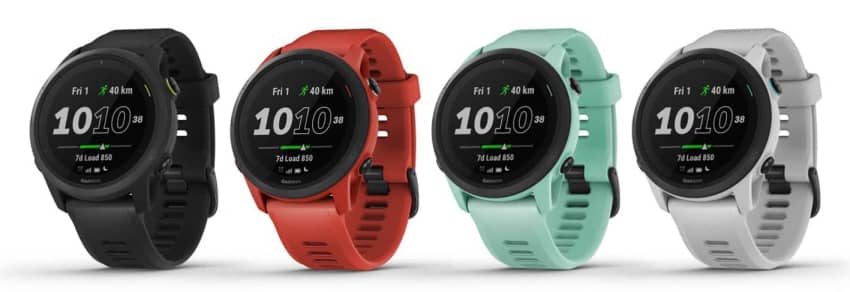
Sensors: everything is there!
This new model is well equipped in terms of sensors. It has the same equipment as the Forerunner 945: a multi-GNSS GPS chip (GPS, Galileo and GLONASS compatible), a barometer, a barometric altimeter that can be calibrated manually or automatically, an optical heart rate monitor on the wrist that works underwater, a pulse oximeter (SpO2) to measure blood oxygenation, a compass, a thermometer, a gyroscope and an accelerometer.
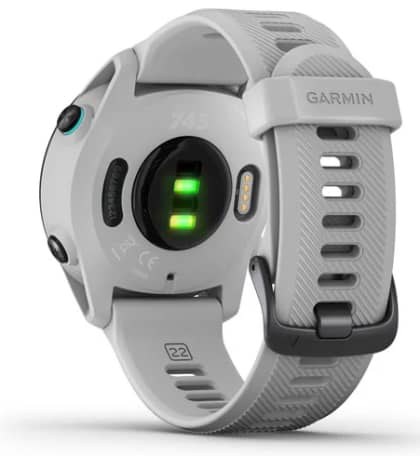
External sensors with ANT+ and Bluetooth Smart transmission can be coupled to the watch: Garmin cardio belt or armband, cycling sensors (power, cadence, speed, electric derailleurs such as Shimano Di2), running sensors (stride/footpod, power, cadence), accelerometer, temperature sensor, VIRB camera, inReach satellite communication beacon, bluetooth headset or earpiece.
Forerunner 745 is also compatible with VARIA speed cameras and lights (to see and be seen by motorists) and ANT+ FE-C Smart Trainers (to control the device directly from the watch and adjust braking to the terrain when navigating along a programmed route).
Finally, it embeds an NFC chip for contactless payment via the Garmin Pay payment solution. Unfortunately, still very few French banks accept it to date (see the list ).
Autonomy: disappointing!
The autonomy is one of the most important criteria in the choice of a cardio watch. It must be large enough to last the duration of an outing but also so that you don't have to recharge your watch every day, as is the case with the Apple Watch!
But the Forerunner 745 is far from breaking records. 16 hours in GPS training at most. For a top-of-the-range watch designed for triathlons, that's not much! Its autonomy is not even equal to that of the Forerunner 245, the smaller mid-range model designed for running. It is also far from the 36 hours of the Forerunner 945. This limits it considerably. It cannot be used for long-distance events (ultratrail, ultramarathon) and for regular athletes, it will need to be recharged often.
Unlike the Fenix 6 Solar series or the recent Garmin Enduro, the Forerunner 745 has neither solar charging nor a battery manager to extend its autonomy when necessary, for example by disabling the optical heart rate monitor. This is a shame, especially as the connector on the back of the watch does not allow charging when the watch is worn on the wrist. However, it can be recharged during an activity, by taking a break or putting it in a pocket.
| Mode | Garmin Forerunner 745 | Garmin Forerunner 945 | Garmin Enduro | Polar Vantage M2 | Polar Vantage V2 |
|---|---|---|---|---|---|
| Watch with HR tracking | 7 d | 14 d | 50 (60*) d | 5 d | 7 d |
| GPS training | 16 h | 36 h | 60 (66**) h | 30 h | 40 h |
| GPS + Music | 6 h | 10 h | - | - | - |
| Ultra | 21 h | 60 h | 120 (148**) h | 100 h | 100 h |
| Battery manager | • | • | • | • | |
| Display remaining time | • | • | • | • | |
| Rechargeable during activity | • | • | • | ||
| Rechargeable on the wrist | |||||
| Solar charging | • |
Sports functions: ultra-complete
Forerunner 745 offers more than 35 comprehensive sports profiles and a host of tools, statistics and physiological measurements to train, track and optimise performance.
Apart from the mapping, you'll find almost all the features of the Forerunner 945: running and cycling dynamics, advanced workout programming, run time predictor, new workout suggestion feature, Strava, Virtual Partner and Virtual Racer, ClimbPro, PacePro and much more.
The functions for running, cycling, swimming and outdoor are very comprehensive. So are the physiological measurements (VO2max, lactic threshold, Training Effect, recovery time, training status and load, training benefit, breathing rate, Body Battery, blood oxygenation, heat and altitude acclimatisation). It's hard to beat that!
These functions are described in more detail below.
Sports profiles: a true multi-sport watch
This triathlon watch is first and foremost a true multi-sport watch, capable of chaining activities together without stopping recording (total distance, time and other data are thus kept throughout the event). It is suitable for triathlons, swimruns and other linked activities.
But it offers much more, with over 35 outdoor and indoor activities.
Of course, we find the activities of triathlon: cycling, running, swimming (sea or pool), with, for the latter activity, complete functions including heart rate recording underwater, detection of the type of swimming, swimming efficiency (SWOLF score), a training log, programming of workouts. An Athletic Track profile offers extraordinary accuracy. The watch is able to correct GPS errors by learning the course after 2 completed laps (data is stored for future outings).
The presence of the barometric altimeter, ABC sensors, advanced GPS navigation functions and dedicated profiles make it suitable for outdoor activities (hiking, skiing, snowboarding, cross-country skiing, off-piste skiing), trail riding, mountain biking, gravel biking and cyclocross. For ski trips, the watch records the number of runs, displays a summary of the data for each run and pauses automatically when you go up the ski lifts. It analyses the movements and identifies the time of descent.
The watch is also suitable for water sports (rowing, standing paddle, kayaking).
Indoor activities are also numerous with profiles for fitness equipment (elliptical, treadmill, stepper, rowing machine, home trainer), yoga, Pilates or weight training with repetition counting in particular.
And if that's not enough, Garmin offers the possibility to create your own profiles from existing profiles. This allows you to organise the data to be displayed from sensors or tools such as ClimbPro, Strava alerts, 3D speed.

Training tools
Garmin offers a rich palette of tools, sometimes a little complex to use, but very powerful to train, analyse your rides and optimise your performance. It's easy to get lost. In comparison, Polar offers powerful tools that are more targeted and a little more practical but also a little more limited.
New features, which by the way are also integrated into the Forerunner 945, include Daily Training Suggestions, a function that is quite similar to Suunto's adaptive training or Polar's FitSpark function. Basically, the watch suggests activities to do for running and cycling, taking into account past training and current training load. The idea is not to train for a competition but rather to maintain what you have learned.
The main tools, some of which are described in more detail in our detailed review of the Forerunner 945, include :
- Running Dynamics: relevant information on one's stride allowing one to analyse a running outing and improve the following outings: running power, ground contact time, ground contact time balance, cadence, stride length, vertical oscillation, vertical ratio. To take full advantage of this, you need the right sensor (Running Dynamics Pod or HRM-Tri, HRM-Run or HRM-Pro belt). These measurements are also available for cycling and swimming.
- A running time predictor indicating the estimated time to run a 5km, 10km, half-marathon or marathon event, based on measured fitness.
- Programming workouts including split. Workouts can be programmed from the Garmin Connect platform and loaded into the watch. They then appear in the "Calendar" widget on the watch. Garmin Coach, in particular, is a powerful tool for preparing for a race (5km, 10km, half marathon or marathon). You indicate a distance objective and a date, and choose a coach from among 3 available personalities. Garmin then draws up a personalised plan, to be downloaded to the watch, which will be adapted according to the performance achieved.
- Daily training suggestion: a new feature offering recommendations for cycling and running activities to maintain gains. These are based on past training and current fitness levels.
- Configurable alerts: Garmin offers a very flexible solution for programming alerts to reach your goals. More than a dozen data can be taken into account (speed, pace, altitude, pace, calories, cadence, proximity, etc.). The watch sends out an alert when you reach a threshold or leave a defined zone (low and high limits).
- Virtual Partner and Virtual Racer to compete against yourself or other athletes (previous activity recorded in the watch or run by a Garmin community member) or against a virtual opponent programmed to run at a given pace. This can provide more motivation to train.
- Strava segments to measure yourself or others on a section of route that you have pre-programmed or located on Strava and loaded onto the watch. The watch recognises the segment and displays the lead or lag, the time taken, etc. The data is automatically transferred to Strava after the session.
- ClimbPro to manage your climbs (cycling, running, trail, hiking or ski touring) with slope profile and data display (read below).
- PacePro allows you to adopt a running pace with a predefined time target. The watch calculates the pace to be adopted and adapts it according to the profile (climbs, descents).
The watch also offers automatic pause, manual or automatic lap recording. It can provide audio instructions (to be listened to with bluetooth earphones).
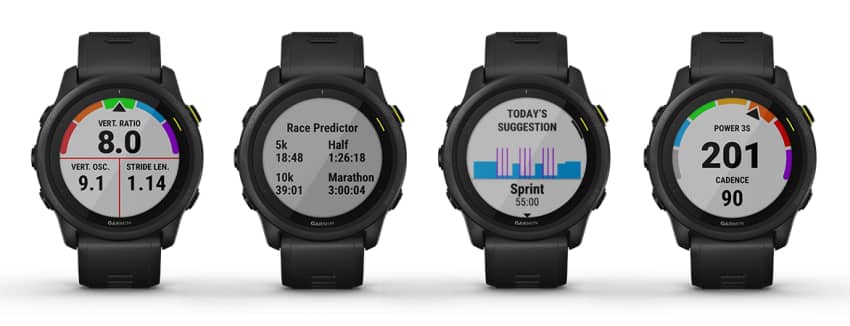
The enhanced ClimbPro function
ClimbPro is a powerful tool to assist the sportsman in his outings. Originally designed for cyclists, the function analyses, in real time, the altimetric profile of the route and displays a colour graph of the slope profile as well as all the useful data for managing a climb (slope, distance to the summit, altitude difference remaining to be climbed, distance travelled since the start of the climb)

The analysis of the route is carried out from the maps stored in the watch (if it has cartography) or from a preloaded route. On the Forerunner 745, it is therefore necessary to follow a programmed route in order to benefit from it.
Garmin has continually improved the feature, especially since the release of the Garmin Enduro (the equivalent of the Forerunner 945 but with record battery life). ClimbPro can now be used with running, trail, hiking and ski touring profiles. Downhill and flat are now taken into account except for cycling. This is a really good thing for trail running where downhill runs can also be challenging.
Another new feature is that you can now program start-of-climb alerts (the watch warns you when you reach the foot of a pass or a programmed distance).
More accurate VO2max estimation for trail running
Another novelty brought with the Garmin Enduro and available on the Forerunner 745 and 945 or the Fenix 6, the VO2max, for the Trail profile, now takes into account the difficulties linked to the terrain (in addition to altitude, altitude variations and temperature). The effort is not the same on muddy ground as on dry ground for example. You will expend more energy and this has an impact on the value of the indicator. An inaccurate VO2max has an impact on the other measures that result from it, such as the training status. Any improvement in this area is therefore welcome. Garmin uses the accelerometer to assess the difficulty of the terrain.
Physiological measurements and performance evaluation
They provide precise information on physical condition, quality of training, level achieved, efforts made and recovery. These indicators make it possible to evaluate progress and optimise performance in future training sessions. The Firstbeat algorithm is used to calculate them.

The new Garmin takes all the measurements already offered by the Forerunner 945 with the exception of the measurement of breathing rate during activity:
- VO2max: the value is corrected for temperature and altitude (see below, acclimatisation). The type of terrain is also taken into account for the Trail profile.
- Training Effect Aerobic and Anaerobic
- Recovery time
- Training load
- Training status
- Training load target
- VFC (Heart Rate Variability) stress test performed at rest, with a cardio belt. The watch establishes a score from 1 to 100.
- Physical fitness: this is an effort test but instead of being performed at rest, like the VFC effort test, it is performed in the field through a short activity (6 to 20 minutes)
- Main benefit (Training Effect labels)
- Lactic threshold: the watch estimates the lactic threshold by detecting the HR at which the muscles start to fatigue
- Breathing rate 24/7: this is assessed from the variability of the heart rate (it increases when breathing in and decreases when breathing out)
- Blood oxygenation (SpO2): for sleep analysis (to detect possible sleep apnea, a pathology that needs to be treated) or to monitor blood oxygen levels during high altitude ascents
- Acclimatisation to heat and altitude: Garmin uses the oximeter and weather data (for temperature) for this. You therefore need a smartphone to take advantage of this. The evaluation is only carried out if the temperature is above 22°C and you are training above 800 metres.
- Instantaneous, average, maximum, resting heart rate
A detailed description of these functions can be found on the Garmin website https://www.garmin.com/fr-FR/garmin-technology/running-science/#running-dynamics#running-dynamics.

Functions for running, cycling, swimming and outdoor
Garmin offers a full range of features for these activities, which we summarise in the table below and compare to the Forerunner 735 XT and Forerunner 945.
The watch is compatible with running (Stryd, HRM-Run belt, HRM-Tri, HRM-Pro, Running Dynamics Pod) and cycling (Vector, etc.) power sensors as well as VARIA products (radar, lights, vision).
| Function | 735 XT | 745 | 945 |
|---|---|---|---|
| Sports profiles | 15 | 35+ | 35+ |
| Running | |||
| Profiles | Walking, treadmill, trail, indoor running | Running, treadmill, indoor running, virtual running, trail running, athletic track | Running, treadmill, indoor running, virtual running, trail running, athletic track |
| Distance, time, pace | • | • | • |
| Running training | • | • | • |
| Running dynamics (stride length, etc.) | • | • | • |
| Running time predictor | • | • | • |
| Speed and cadence sensor support | • | • | • |
| Stryd power sensor support | • | • | |
| Lactic threshold | • | • | • |
| Bike | |||
| Profiles | Cycling, indoor cycling | Bike, indoor bike, mountain bike, gravel bike, cyclocross, home trainer | Cycling, indoor cycling, mountain biking, gravel biking, cyclocross, home trainer |
| Comparison to previous activities | • | • | • |
| Race against an activity | • | • | • |
| Time/distance alarm | • | • | • |
| Cadence sensor compatibility | • | • | • |
| Varia compatible (vision, radar, lights) | • | • | • |
| Power sensor compatible | • | • | • |
| Vector support | • | • | • |
| Advanced Vector support | • | • | |
| FTP | • | • | • |
| Round trip generator | • | • | |
| Road and bike maps | • | ||
| Swimming | |||
| Profiles | Pool | Swimming pool, open water, swimrun | Pool, open water, swimrun |
| Swimming metrics | • | • | • |
| Swim type detection | • | • | • |
| Swimming efficiency (SWOLF) | • | • | |
| Recording of exercises | • | • | • |
| Swimming workouts | • | • | • |
| Open water swimming metrics | • | • | • |
| HR measurement and tracking | • | • | • |
| Wrist HR underwater | • | • | |
| Outdoor | |||
| Profiles | NC | Hiking, climbing, skiing, snowboarding, cross-country skiing, off-track skiing, cross-country skiing and skating, stand-up paddle, rowing, kayaking | Hiking, climbing, skiing, snowboarding, cross-country skiing, backcountry skiing, classic cross-country skiing and skating, stand-up paddle, rowing, kayaking |
| Point to point navigation | • | • | • |
| Real time breadcrumb trail | • | • | • |
| Return to the start | • | • | • |
| Return to the start by the same route (Trackback) | • | • | |
| Distance to destination | • | • | • |
| "Around me" mode | • | ||
| Altitude profile | • | • | |
| Future altitude profile | • | • | |
| Vertical speed | • | • | |
| Total ascent/descent | • | • | |
| Climb planner (ClimbPro) | • | • | |
| GPS coordinates | • | • | • |
| See & rally | • | • | |
| Projected waypoints | • | ||
| Onboard topographic maps | • | ||
| Barometric trend indicator | • | • | |
| Moon/sun information | • | • | |
| Fishing & hunting calendar | • | • | |
| XERO position (archery, rifle sight) | • |
GPS navigation: everything is there except the mapping

The new model includes all the GPS navigation functions offered by Garmin on the Forerunner 945, with the exception of mapping and the functions that use it.
The watch, in addition to displaying the GPS track, can follow a programmed route with turn-by-turn directions. It indicates the distance to the next turn and the direction to follow. It can return to the starting point by following the track in the opposite direction (TrackBack function).
The ClimbPro function analyses the elevation profile of the terrain and provides useful data for better management of ascents and descents, but requires that you follow a recorded route.
The Forerunner 745 has the round trip route generator (roads and cycle paths) and the Trendline function (access to heat maps, i.e. the most popular routes taken by members of the Garmin community) but only from the Garmin Connect platform. You will then have to load the routes you have obtained onto the watch.
Connected functions
Garmin offers interesting functions to complement the sports functions. They may seem like gadgets, but they are useful depending on the sport practised, habits and comfort required. We find in particular:
- Smartphone notifications: messages (SMS, Whatsapp, etc.), emails, calls
- MP3 player to listen to music anywhere, without having to take your smartphone with you. Of course, you have to wear bluetooth earbuds. You can also listen to streaming music on Deezer, Amazon Music or Spotify (paid subscription).
- Contactless payment solution: the watch is equipped with an NFC chip. You will be able to pay for your purchases provided you find a bank that has developed a partnership with Garmin!
- Weather forecast over 2 days
- Sunrise and sunset times.
- Hunting and fishing calendar
- Calendar for accessing scheduled workouts or your Google calendar
- Control of a VIRB camera.
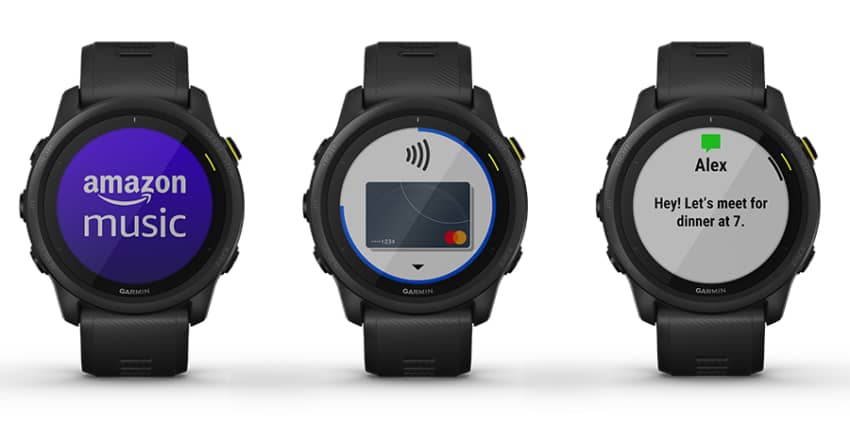
Security functions
The watch offers the features now available on all new Garmin watches: fall detection and automatic or manual SOS call function, LiveTrack for tracking on the Internet. Forerunner also offers Group LiveTrack, to track a group of athletes wearing a Garmin watch with this feature.
Activity and health monitoring
The range of functions is growing steadily. There are no new features here: the functions already present on the Forerunner 945 are included:
- Assessment of blood oxygen level (SpO2)
- Assessment of the level of stress (effort)
- Breathing rate but not during activity (unlike the Forerunner 945)
- The intensive minutes
- The Body Battery: an estimate of the body's energy level on a scale of 0 to 100, taking into account recovery including during the day. The score increases when you rest and decreases when you are active.
- Classic data: steps, distance, heart rate monitoring, calories, number of floors climbed
- Sleep monitoring (phases, duration, blood oxygenation, breathing, bedtime/waketime)
- Menstrual cycle monitoring for women
- Monitoring hydration

Our opinion on the Garmin Forerunner 745
The Forerunner 745 is a running and triathlon watch packed with sensors and offering ultra-complete functions for training and optimising performance. It offers the equivalent functions of the Forerunner 945 or the Fenix 6, the top of the range, but without the mapping. It costs a little less. It will undoubtedly appeal to triathletes and runners looking for powerful tools and advanced statistics.
On the other hand, its autonomy is disappointing. With only 16 hours, it will not be possible to use it for long races and it will often have to be recharged if you do sport regularly, especially as it offers neither solar charging nor an intelligent battery manager. This is a big concern for a triathlon watch designed for athletes who train regularly.
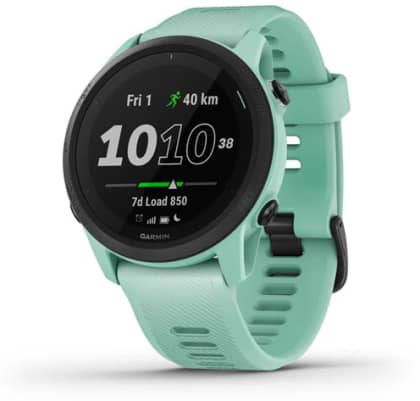
Moreover, its price is high. The point of the model is not to pay more for a map that you will not use. But with the price drop of the Forerunner 945 and the promotions often offered on this model already dating from 2019, the difference is not so great: barely 50 €. At this price, one may be tempted to pay a little more for a more than doubled autonomy and a cartography that can be useful on occasion, if only to use the ClimbPro and PacePro functions without having to pre-load a route and follow it! Or to find a route around you when you go to train in an unfamiliar place. Read our detailed review of the Forerunner 945.
It should also be said that we were expecting a mid-range model to replace the Forerunner 735XT, with less advanced functions but at a more accessible price. Garmin seems to prefer to target an audience that is determined to pay a premium price for high-end watches whose prices continue to rise over the years. If you want a cheap triathlon watch, then you'll have to look at Polar's new 5.96 Vantage M2 or 5.69 Coros watches.
So why buy the Forerunner 745? Apart from the price, which is only slightly lower than that of the Forerunner 945 (which should not be overlooked either), the only real advantage of this watch is its compact size, which suits even the thinnest of wrists, and its slightly lighter weight. This is not negligible for a watch that you will wear for hours and that you want to be as comfortable as possible in events like triathlons.
Verdict
The Garmin Forerunner 745 is a top-of-the-range multisport watch for running and triathlon that offers almost the same functions as the Forerunner 945 and the Fenix 6, the top of the Garmin sports watches, but without the mapping. It should appeal to sportsmen and women on a budget who are looking for a watch that is both reliable and rich in sports functions but without having to pay more for mapping that they don't need. It is particularly interesting for running, triathlon and swimming or outdoor activities, with profiles and really complete functions for these activities. However, it suffers from a somewhat low battery life. Its small size, compared to the Forerunner 945, is an advantage, especially for small wrists. In terms of measurement reliability, it is excellent.
For a complete but less expensive triathlon watch, we recommend the Polar Vantage M2. For a better autonomy, you should choose the Garmin Forerunner 945. See also our comparison of the best triathlon watches.
- Compact size and weight
- Ultra-comprehensive features (equivalent to Forerunner 945 without mapping)
- High price despite no mapping
- Low battery life
- No charging possible during the race without removing the watch from the wrist!
Price and availability
The Garmin Forerunner 745 is available for sale at a recommended retail price of £499. Check it out at our partners and take advantage of discount coupons all year long.
These articles may also interest you
Garmin Forerunner 945: the triathlon watch with music and cartography
Comparaison Garmin Forerunner 745 vs 735XT et 945 : 3 montres Garmin pour le triathlon
Polar Vantage M2 : le bon compromis pour le running et le triathlon
Comparison Coros Pace vs Coros Apex vs Coros Apex Pro vs Coros Vertix
Meilleures montres GPS 2025 pour le triathlon
Photo credit : Adobe Stock. This article contains commercial links.

